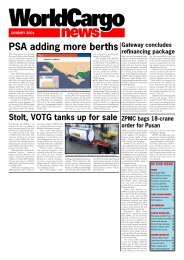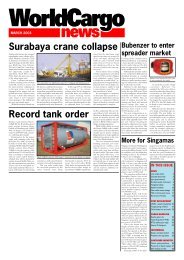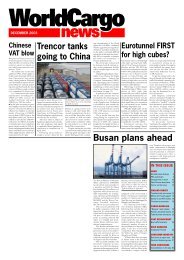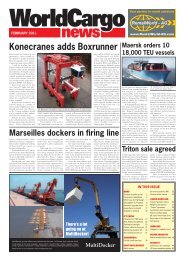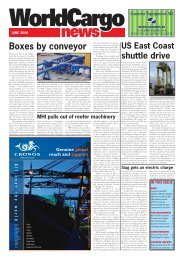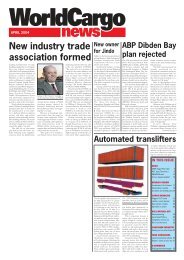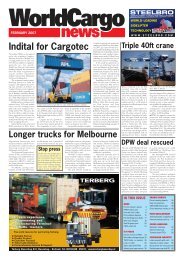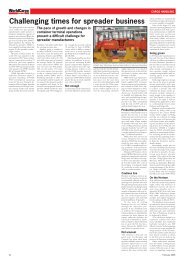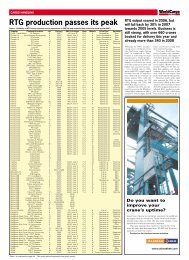Tanjung Priok super port - WorldCargo News Online
Tanjung Priok super port - WorldCargo News Online
Tanjung Priok super port - WorldCargo News Online
Create successful ePaper yourself
Turn your PDF publications into a flip-book with our unique Google optimized e-Paper software.
PORT DEVELOPMENT<br />
Global operators on a roll<br />
The past four years have<br />
seen huge variations<br />
in annual container<br />
throughputs, with 2009 seeing<br />
the first decline (-10%) in the<br />
industry’s history, 2010 a strong<br />
return to growth (12%) and 2011<br />
and 2012 more modest increases<br />
in the 4-6% range. This year most<br />
analysts are expecting growth in<br />
the 5-6% range.<br />
Although global terminal operators<br />
(GTOs) scaled back on their<br />
capital expansion programmes<br />
slightly in the fiscally constrained<br />
2008-10 period, they still invested<br />
and secured new operating concessions.<br />
For the past 20 years or<br />
so, the sector has seen a constant<br />
increase in its share of the global<br />
container market. This is a situation<br />
that is expected to continue,<br />
despite some renewed interest in<br />
<strong>port</strong>s and terminals from equity<br />
groups, financial intermediaries<br />
and pension funds.<br />
But the GTOs will be operating<br />
in a slower trading environment<br />
with annualised growth<br />
rates of only 5-6% a year expected<br />
over the next decade. This compares<br />
with average volume rises<br />
of 10-12% a year throughout the<br />
1990s and 2000s, a period that<br />
was characterised by robust traffic<br />
rises and hundreds of new deals<br />
being concluded by the main international<br />
terminal operators/<br />
stevedores as they gained ground<br />
in the industry.<br />
Maturing sector<br />
While the slower rates of growth<br />
in container handling activity<br />
partly relate to poorer global economic<br />
growth prospects, especially<br />
in the OECD countries, they<br />
also reflect the maturing nature of<br />
the container shipping industry.<br />
In many regions of the developed<br />
world well over 80% of general<br />
and neo-bulk cargoes – such as<br />
steel, lumber and forest products –<br />
have already been unitised.<br />
Having said this, there remains<br />
a significant volume of refrigerated<br />
cargo that is moved in specialised<br />
ships, while a range of<br />
agricultural commodities, such as<br />
soya beans, lentils, some grain and<br />
ores, are moved conventionally<br />
and could be containerised if the<br />
right infrastructure were in place.<br />
Geographically, it is the<br />
emerging markets that offer<br />
the GTO industry the best<br />
prospects, principally because:<br />
• Annualised rates of growth over<br />
the next 10 years in regions such<br />
as Africa, Latin America and<br />
Concessions catapult capacity<br />
All the main global terminal operating<br />
companies have sizeable<br />
operating and investment concessions<br />
in place which are due<br />
to deliver a significant amount<br />
of additional container handling<br />
capacity over the next two to<br />
three years.<br />
A conservative estimate suggests<br />
that by the end of 2015,<br />
six leading GTOs – HPH, PSA<br />
International, DP World, APM<br />
Terminals, China Merchants<br />
Holdings International and Cosco<br />
Pacific – collectively will<br />
have added 30M-35M TEU of<br />
annualised handling capacity to<br />
the global total. Of these, DP<br />
World and APMT come out as<br />
being highly ambitious.<br />
DP World’s main projects<br />
are set to add about 12M TEU<br />
of new capacity over the next<br />
two-three years. Around 40%<br />
of this new capacity will come<br />
on stream at its home <strong>port</strong> of<br />
Jebel Ali in Dubai, with 1M<br />
TEU added through its Jebel Ali<br />
Container Terminal 2 extension<br />
project by the end of 2013 and<br />
up to 4M TEU coming into<br />
operation at the new Terminal 3<br />
complex in 2014.<br />
Elsewhere, its Embramar<br />
project in Santos, where it<br />
works with Odebrecht, will add<br />
1M TEU later this year. At London<br />
Gateway at least 1.6M TEU<br />
will come on stream this year,<br />
with the possibility of a further<br />
2M TEU within the next two<br />
years. While there is some uncertainty<br />
about the scheduling<br />
of its Rotterdam World Gateway<br />
complex, it is expected to open<br />
in late 2014 with a design capacity<br />
of 2.4M TEU and eventually<br />
will be able to handle 4M<br />
TEU a year. By 2020 DP World<br />
hopes to have doubled its 2011<br />
handling capacity and have facilities<br />
capable of handling close<br />
to 100M TEU in place.<br />
APMT has an ambitious<br />
expansion programme in<br />
place too, with a goal of<br />
becoming the world’s leading<br />
container <strong>port</strong> and inland services<br />
operator by 2016. On the<br />
basis of new developments, the<br />
operator will phase in to service<br />
an estimated 12M TEU of new<br />
capacity over the next three years.<br />
Due to open in late 2014,<br />
APMT’s Maasvlakte II terminal<br />
is among its biggest projects,<br />
with stage one delivering about<br />
2.7M TEU of extra handling<br />
capacity to the Benelux market,<br />
eventually increasing to 4.5M<br />
TEU, to be phased in according<br />
to market demand. Developments<br />
in the emerging markets<br />
will be responsible for most of<br />
the group’s remaining capacity<br />
increases as terminals in Santos,<br />
Callao, Lazaro Cardenas, Izmir,<br />
Port Moin and Ningbo are<br />
completed.<br />
Hong Kong’s HPH and Singapore’s<br />
PSA International have<br />
fewer concessions and expansion<br />
programmes in place, although<br />
the Singapore Government<br />
is preparing to build an<br />
entirely new box <strong>port</strong> at Tuas<br />
in the west of the island. While<br />
no time frame is known for the<br />
development, PSA’s leases with<br />
the government for its terminals<br />
at Keppel, Pulau Brani and Tanjong<br />
Pagar will expire in 2017.<br />
In the meantime, PSA is focused<br />
on expanding its Pasir<br />
Panjang terminal. An estimated<br />
S$3.5B will be spent on phases<br />
three and four with at least 8M<br />
TEU of additional handling capacity<br />
expected to be in place at<br />
the complex over the next decade.<br />
The next two years will also<br />
see it complete a 1.8M TEU<br />
capacity terminal at Dammam<br />
in Saudi Arabia and add some<br />
capacity at Port Mariel, Cuba.<br />
Outside of the leading pack,<br />
Manila-based ICTSI has secured<br />
a number of high profile<br />
concessions in the last few years<br />
and was recently shortlisted in<br />
the bidding process to build<br />
a third terminal in the <strong>port</strong> of<br />
Melbourne, Australia.<br />
The next two-three years will<br />
see the group introduce new<br />
handling capacity throughout its<br />
network, including at its flagship<br />
facility in Manila, at Manzanillo<br />
in Mexico, Lekki in Nigeria,<br />
Gdynia in Poland and Rijeka<br />
in Croatia. Overall, a projected<br />
4M-5M TEU of new handling<br />
capacity will be added to ICT-<br />
SI’s global <strong>port</strong>folio of facilities<br />
over this period.<br />
Despite high levels of volatility and<br />
uncertainty over container growth<br />
prospects, global terminal operators<br />
continue to invest heavily<br />
parts of Asia are projected to<br />
be three-four times higher than<br />
those in Europe, North America,<br />
Japan and maturing nations in<br />
Asia, such as South Korea, Taiwan<br />
and Singapore.<br />
• There is a rising demand for the<br />
development of modern cargo/<br />
container handling facilities and<br />
associated infrastructure. Local<br />
<strong>port</strong> authorities are often short<br />
of cash or unable to raise the finance<br />
for such projects.<br />
• Rising levels of foreign direct investment<br />
by a mix of companies,<br />
quite often including manufacturers/producers,<br />
dictate that<br />
efficient supply chains are in<br />
place. Fundamentally, this means<br />
efficient <strong>port</strong>s and container terminals<br />
to handle the im<strong>port</strong>/ex<strong>port</strong><br />
flows that normally follow<br />
on from the investment.<br />
APM Terminals (APMT), China<br />
Merchants Holdings (International)<br />
(CMHI), DP World and PSA<br />
International (PSA) are among the<br />
leading GTOs already well-established<br />
in managing terminals in<br />
the developing world. Each is actively<br />
chasing new op<strong>port</strong>unities.<br />
Russian roulette<br />
Last year saw APMT make a key<br />
move into the Russian market, a<br />
region singled out by group CEO<br />
Kim Fejfer as displaying the fastest<br />
growth rates of any BRIC nation<br />
last year and offering sound<br />
prospects. The Netherlandsheadquartered<br />
terminal operator<br />
bought a 37.5% stake in Global<br />
We’re there,<br />
wherever you need us<br />
From Singapore to Uzbekistan, if you’re involved in an<br />
incident, we’ll get someone on site and quickly. With 20<br />
claims offices in key locations, and a further network<br />
of local partners, we always have professionals on<br />
hand with knowledge of the key issues and the legal<br />
frameworks needed to manage a claim effectively.<br />
Because we don’t do anything else, we lead<br />
the way in trans<strong>port</strong> and logistics insurance.<br />
PSA will spend S$3.5B to build an additional 8M TEU of capacity at Pasir<br />
Panjang terminal over the next decade, while the Singapore government is<br />
planning a new box <strong>port</strong> at Tuas in the west of the island<br />
Ports Investments (GPI), Russia’s<br />
leading operator of container terminals,<br />
which also has a presence<br />
in Finland and Latvia. GPI handled<br />
about 1.4M TEU in 2012,<br />
up 8% on 2011, and with about<br />
a 30% share of Russia’s total container<br />
market.<br />
“Russia will need world-class<br />
<strong>port</strong> infrastructure and operational<br />
excellence to serve global shipping<br />
lines and meet its own ambitions<br />
of economic development<br />
and GPI has a ‘good eye’ to grow<br />
the business. This deal is a great op<strong>port</strong>unity<br />
for APMT,” said Fejfer.<br />
He added: “The nation’s rapidly<br />
developing middle class, Russia’s<br />
integration with the global<br />
economy as evidenced by its<br />
membership of the WTO plus<br />
the country’s wealth of natural<br />
resources will continue to fuel the<br />
growth in ex<strong>port</strong>s and im<strong>port</strong>s in<br />
the long run.”<br />
GPI controls the Petroles<strong>port</strong><br />
and Moby Dik terminals in St<br />
Petersburg – a total operating<br />
capacity of 1.8M TEU – as well<br />
as the city’s Yanino Logistics Park.<br />
May 2013 59



